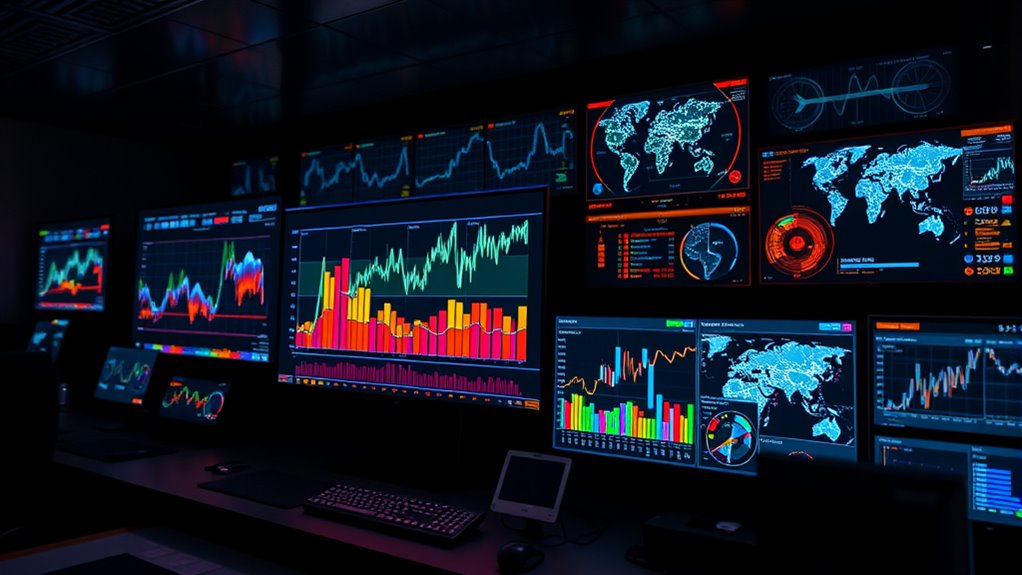Real-time data visualization helps you make quick, informed decisions by providing instant insights from sensor data and live updates. It allows you to identify issues, spot trends, and react proactively before problems escalate. Customizable dashboards make it easy to focus on what matters most, while color-coded alerts and visual tools simplify complex information. If you want to learn how this technology can boost your decision-making process and improve workflows, there’s more to explore ahead.
Key Takeaways
- Enables immediate insights, helping decision-makers respond swiftly to operational changes.
- Integrates sensor data for comprehensive, real-time monitoring of systems and environments.
- Customizable dashboards highlight critical metrics and anomalies for quick assessment.
- Facilitates proactive decisions by visualizing trends and potential issues as they occur.
- Supports dynamic adjustments and scalability to adapt to evolving data sources and KPIs.

Have you ever needed immediate insights from your data? In today’s fast-paced environment, waiting for reports or batch updates isn’t enough. You need real-time data visualization to make quick, informed decisions. This is where sensor integration becomes vital. By combining data from various sensors, you get a continuous flow of live information from machines, environments, or other sources. Sensor integration allows your systems to collect accurate, up-to-the-second data, which can then be visualized instantly. The challenge lies in organizing this influx of information in a way that’s easy to interpret. That’s where dashboard customization comes into play. With customizable dashboards, you can tailor the visual display to show exactly what matters most to you—be it temperature fluctuations, equipment performance, or customer activity. You can choose the types of charts, graphs, and metrics that fit your needs, making complex data more accessible and actionable. When you have sensor data feeding into a well-designed dashboard, you’re equipped with an extensive view of your operations at any given moment. This setup minimizes guesswork, highlighting anomalies or trends as they happen. For example, if a sensor detects a drop in pressure, your customized dashboard can immediately flag this issue with color-coded alerts, prompting quick intervention. The power of real-time visualization isn’t just in monitoring; it’s about proactive decision-making. You can identify potential problems before they escalate, optimize workflows based on live data, and respond swiftly to changing conditions. Integrating sensors and customizing dashboards also streamline communication across teams. Everyone sees the same real-time data, reducing misunderstandings and aligning efforts toward common goals. Additionally, the flexibility of dashboard customization means you can adjust your view as your priorities evolve. Need to focus on a new KPI? Just tweak the dashboard. Want to add a new sensor source? It’s often a straightforward process. This adaptability ensures you stay agile in a dynamic environment. Leveraging smart utilities can further enhance your data insights by optimizing energy use and resource management. Ultimately, the combination of sensor integration and dashboard customization empowers you to transform raw data into actionable insights instantly. It shifts decision-making from reactive to proactive, giving you a competitive edge. You’re no longer limited by delayed reports or static data; instead, you harness a real-time, intuitive view of your operations. This approach not only enhances efficiency but also boosts confidence in your decisions, knowing they’re based on the freshest, most accurate data available.
Frequently Asked Questions
How Does Real-Time Visualization Impact Data Security?
Real-time visualization impacts data security by increasing cybersecurity risks and challenging data privacy. As you stream sensitive information instantly, you must implement strong encryption and access controls to prevent breaches. You also need to monitor for unauthorized access continuously. While it speeds up decision-making, it’s essential to balance quick insights with robust security measures, ensuring that data privacy isn’t compromised in the process.
What Are the Best Tools for Integrating Live Data Sources?
You can’t afford to fall behind, so focus on tools that excel in data streaming and API integration. Platforms like Power BI, Tableau, and Grafana are top choices, offering seamless live data source integration. They let you connect effortlessly to APIs and stream data in real time, empowering you to make quick, informed decisions. Don’t let outdated tools hold you back—embrace these powerful solutions to stay ahead.
How to Handle Data Inaccuracies in Real-Time Dashboards?
To handle data inaccuracies in real-time dashboards, you should implement data validation processes to catch errors early and guarantee data quality. Incorporate anomaly detection algorithms to identify unusual patterns or outliers quickly. When you detect inaccuracies, set up automated alerts to notify you promptly, allowing you to address issues swiftly. Regularly review your validation rules and detection methods to adapt to evolving data sources and maintain dashboard reliability.
What Skills Are Needed to Develop Real-Time Visualizations?
Think of yourself as a data wizard, blending skills in data processing and visualization techniques. You need to master programming languages like Python or JavaScript, understand database management, and have a good eye for design. Your ability to interpret real-time data, create clear visuals, and troubleshoot issues quickly makes complex information accessible. These skills enable you to craft dynamic dashboards that empower decision-makers, much like a maestro conducting a symphony of data.
How Does Real-Time Data Visualization Influence User Decision-Making?
Real-time data visualization boosts your decision-making by increasing user engagement and enabling quick trend analysis. When you see live updates, you’re more likely to spot patterns and respond swiftly to changes. This immediate feedback helps you make informed choices, adapt strategies, and stay ahead of the competition. By visualizing data in real-time, you turn complex information into clear insights, empowering you to act confidently and efficiently.
Conclusion
Think of real-time data visualization as your lighthouse in a stormy sea, guiding you safely through turbulent waters. It transforms chaos into clarity, helping you make confident decisions when every second counts. With this powerful tool, you’re the captain steering your ship with precision, not lost in the darkness. Embrace it, and let your insights shine brightly, illuminating your path forward amidst the unpredictable waves of data.









